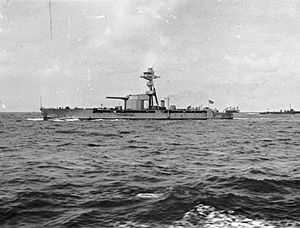HMS Marshal Soult
 HMS Marshal Soult | |
| Career (UK) | |
|---|---|
| Name: | HMS Marshal Soult |
| Namesake: | Marshal Nicolas Jean de Dieu Soult |
| Builder: | Palmers, Jarrow |
| Launched: | 24 August 1915 |
| Commissioned: | August 1915 |
| Fate: | Sold July 10 1946 |
| General characteristics | |
| Class and type: | Marshal Ney-class monitor |
| Displacement: | 6,670 long tons (6,780 t) (standard) 6,900 long tons (7,000 t) (full load) |
| Length: | 340 ft (100 m) (p.p.) 355 ft 7.2 in (108.387 m) (o/a) |
| Beam: | 90 ft 3 in (27.51 m) |
| Draught: | 10 ft 6 in (3.20 m) |
| Installed power: | 1,898 hp (1,415 kW) (trials) 1,500 hp (1,100 kW) (service) |
| Propulsion: | 2 × Vickers diesel engines 2 × screws |
| Speed: | 9 kn (10 mph; 17 km/h) (design) 6.6 kn (7.6 mph; 12.2 km/h) (trials) 6 kn (6.9 mph; 11 km/h) (service) |
| Capacity: | Diesel fuel: 235 short tons (213 t) (maximum) |
| Complement: | 228 |
| Armament: | As built:
1917:
1918:
|
| Armour: |
|
HMS Marshal Soult was a Royal Navy Marshal Ney-class monitor constructed in the opening years of the First World War. Laid down as M14, she was named for the French general of the Napoleonic Wars Marshal Nicolas Jean de Dieu Soult. She served in both World Wars and was decommissioned in 1946.
Design
Designed for inshore operations along the sandbank strewn Belgian coastline, Marshal Soult was equipped with two massive 15-inch (380 mm) naval guns. Originally, these guns were to have been stripped from one of the battlecruisers Renown and Repulse after they were redesigned. However the guns were not ready, and guns intended for the battleship Ramillies were used instead. The diesel engines used by the ships were a constant source of technical difficulty, restricting their use.
Service
Marshal Soult performed numerous bombardment operations against German positions in Flanders, including during the First Ostend Raid in April 1918. In October 1918, she became a tender to the gunnery school HMS Excellent at Portsmouth and in March 1919 undertook a similar role at Devonport before paying off in March 1921. Recommissioned in 1924, she moved to Chatham in April 1926 as a training ship.
Her armament was removed in March 1940 and was later fitted to the new Roberts-class monitor Abercrombie, which was completed in 1943.
Fate
She served throughout the Second World War as a depot ship for trawlers at Portsmouth until being sold on 10 July 1946 and scrapped at Troon.
References
- Dittmar, F. J. & Colledge, J. J., "British Warships 1914-1919", (Ian Allan, London, 1972), ISBN 0-7110-0380-7
- Gray, Randal (ed), "Conway's All The Worlds Fighting Ships, 1906–1921", (Conway Maritime Press, London, 1985), ISBN 0-85177-245-5
- Taylor, Michael J.H. (1990). Jane's Fighting Ships of World War I. Studio. ISBN 1-85170-378-0.
| ||||||||||